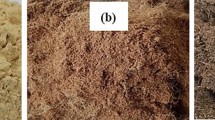Abstract
Water absorption of wood plastic composites (WPCs) manufactured from sawdust and virgin and recycled plastics (HDPE and PP) was studied. Wood flour was prepared from sawdust and mixed with different virgin or recycled plastics at 50% by weight fiber loading. The mixed materials were compression molded into panels. Water absorption of manufactured WPCs was determined after 2 and 24 h immersion in distilled water at different temperatures (25, 50 and 70 °C). WPCs containing recycled plastics exhibited higher water absorption especially when the two recycled plastics were mixed together. Immersion temperature had a significant effect on water absorption.
Zusammenfassung
Die Wasseraufnahme von aus Sägespänen und Primär- sowie Recyclingkunststoff (HDPE und PP) hergestellten Holz-Kunststoff-Verbundplatten wurde untersucht. Aus Sägespänen wurde Holzmehl hergestellt und mit verschiedenen Primär- und Recyclingkunststoffen mit einem Masseanteil von 50% vermischt. Das Materialgemisch wurde zu Platten formgepresst. Die Wasseraufnahme der hergestellten WPCs wurde nach 2- und 24-h Lagerung in destilliertem Wasser bei unterschiedlichen Temperaturen (25, 50 und 70 °C) untersucht. Dabei war die Wasseraufnahme von WPCs aus Recyclingkunststoff höher, insbesondere wenn die beiden Recyclingkunststoffe gemischt waren. Die Temperatur bei der Wasserlagerung hatte großen Einfluss auf die Wasserabsorption.
Similar content being viewed by others
References
ASTM D580-98 (1998) Standard Test Method for Water Absorption of Plastics. American Society for Testing and Materials
Avila AF, Duaret MV (2003) A mechanical analysis on recycled PET/HDPE composites. Polym Degrad Stabil 80:373–382
Bao LR, Yee AF (2002) Effect of temperature on moisture absorption in bismaleimide resin and its carbon fiber composites. Polymer 43:3987–3997
Chow P, Bajwa DS, Lu W, Youngquist JA, Stark NM, Li Q, Cook CG (1998) Injection-molded composites from Kenaf and recycled plastic. Proceedings of the 1st Annual American Kenaf Society Meeting, San Antonio, TX, USA
Espert A, Vilaplana F, Karlsson S (2004) Comparison of water absorption in natural cellulosic fibers from wood and one-year crops in polypropylene composites and its influence on their mechanical properties. Compos Part A 35:1267–1276
George J, Sreekala MS, Thomas S (2001) A review on interface modification and characterization of natural fiber reinforced plastic composites. Polym Eng Sci 41(9):1471–1485
Jayaraman K, Bhattacharyya D (2004) Mechanical performance of wood fiber-waste plastic composites material. Resour Conserv Rec 41:307–319
Kamdem DP, Jiang H, Cui W, Freed J, Matuana LM (2004) Properties of wood plastic composites made of recycled HDPE and wood flour from CCA-treated wood removed from service. Compos Part A 35:347–355
Kazemi Najafi S, Hamidinia E, Tajvidi M (2006) Mechanical properties of composites from sawdust and recycled plastics. J Appl Polym Sci 100:3641–3645
Merdas I, Thominette A, Tcharkhtchi A, Verdu J (2001) Factors governing water absorption by composite matrices. Compos Sci Technol 62:487–492
Mishra S, Naik JB (1998) Absorption of water at ambient temperature and steam in wood–polymer composites prepared from agro-waste and polystyrene. J Appl Polym Sci 68:681–686
Nitz H, Reichert P, Römling H, Mülhaupt R (2000) Influence of compatibilizers on the surface hardness, water uptake and the mechanical properties of poly (propylene) wood flour composites prepared by reactive extrusion. Macromol Mater Eng 276–277:51–58
Optimate Ltd and MERL Ltd (2003) Wood plastic composite study-technologies and UK market opportunities, Research Report. The Waste and Researches Action Programme, UK
Pothan LA, Thomas S (2004) Effect of hybridization and chemical modification on the water-absorption behavior of banana fiber-reinforced polyester composites. J Appl Polym Sci 91:3856–3865
Tajvidi M, Ebrahimi GH (2003) Water uptake and mechanical characteristics of natural filler–polypropylene composites. J Appl Polym Sci 88:941–946
Yadav P, Nema A, Varghese S, Nema SK (1999) News-paper-reinforced plastic composite laminates: mechanical and water uptake characteristics. Polym Eng Sci 39(8):1550–1557
Youngquist JA, Myers GE, Muehl JH, Krzysik AM, Clemens CM (1994) Composites from recycled wood and plastics. USDA Forest Service, Forest Product Laboratory, Madison, W53705–2398
Author information
Authors and Affiliations
Corresponding author
Rights and permissions
About this article
Cite this article
Kazemi Najafi, S., Tajvidi, M. & Hamidina, E. Effect of temperature, plastic type and virginity on the water uptake of sawdust/plastic composites . Holz Roh Werkst 65, 377–382 (2007). https://doi.org/10.1007/s00107-007-0176-6
Published:
Issue Date:
DOI: https://doi.org/10.1007/s00107-007-0176-6




